Related Research Articles
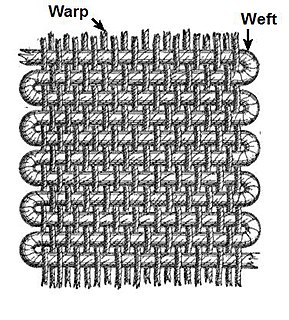
Weaving is a method of textile production in which two distinct sets of yarns or threads are interlaced at right angles to form a fabric or cloth. Other methods are knitting, crocheting, felting, and braiding or plaiting. The longitudinal threads are called the warp and the lateral threads are the weft, woof, or filling. The method in which these threads are inter-woven affects the characteristics of the cloth. Cloth is usually woven on a loom, a device that holds the warp threads in place while filling threads are woven through them. A fabric band which meets this definition of cloth can also be made using other methods, including tablet weaving, back strap loom, or other techniques without looms.

Velvet is a type of woven tufted fabric in which the cut threads are evenly distributed, with a short dense pile, giving it a distinctive soft feel. By extension, the word velvety means "smooth like velvet". Velvet can be made from either synthetic or natural fibers.

Satin refers to the weave of a fabric rather than the material. It typically has a glossy surface and a dull back, one of three fundamental types of textile weaves along with plain weave and twill. The satin weave is characterized by four or more fill or weft yarns floating over a warp yarn, four warp yarns floating over a single weft yarn. Floats are missed interfacings, for example where the warp yarn lies on top of the weft in a warp-faced satin. These floats explain the high luster and even sheen, as unlike in other weaves, the light reflecting is not scattered as much by the fibres. Satin is usually a warp-faced weaving technique in which warp yarns are "floated" over weft yarns, although there are also weft-faced satins. If a fabric is formed with a satin weave using filament fibres such as silk, polyester or nylon, the corresponding fabric is termed a satin, although some definitions insist that the fabric be made from silk. If the yarns used are short-staple yarns such as cotton, the fabric formed is considered a sateen.

Poplin, also called tabinet is a fine, but thick, wool, cotton or silk fabric that has a horizontal warp and a vertical weft. Nowadays, it is a strong fabric in a plain weave of any fiber or blend, with crosswise ribs that typically gives a corded surface.

Flannel is a soft woven fabric, of various fineness. Flannel was originally made from carded wool or worsted yarn, but is now often made from either wool, cotton, or synthetic fiber.
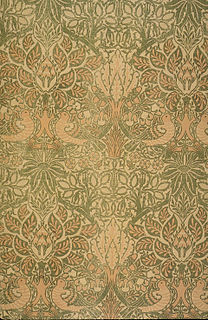
Double cloth or double weave is a kind of woven textile in which two or more sets of warps and one or more sets of weft or filling yarns are interconnected to form a two-layered cloth. The movement of threads between the layers allows complex patterns and surface textures to be created.

Cambric, or batiste, one of the finest and densest kinds of cloth, is a lightweight plain-weave cloth, originally from the French commune of Cambrai, woven greige, then bleached, piece-dyed and often glazed or calendered. Initially it was made of linen; later, the term came to be applied to cotton fabrics as well. Chambray is the same type of fabric, with a coloured warp and white filling; the name "chambray" replaced "cambric" in the United States in the early 19th century.
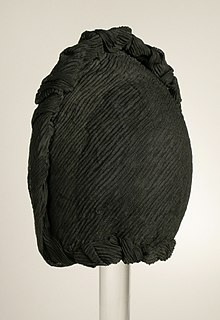
Crêpe, also spelt crepe or crape, is a silk, wool, or synthetic fiber fabric with a distinctively crisp and crimped appearance. The term crape typically refers to a form of the fabric associated specifically with mourning. Crêpe was also historically called crespe or crisp.
Textile manufacturing is a major industry. It is largely based on the conversion of fibre into yarn, yarn into fabric. These are then dyed or printed, fabricated into clothes which are then converted into useful goods such as clothing, household items, upholstery and various industrial products.
Sateen is a fabric made using a satin weave structure but made with spun yarns instead of filament.

Taffeta is a crisp, smooth, plain woven fabric made from silk or cuprammonium rayons as well as acetate and polyester. The word is Persian (تافته) in origin and means "twisted woven". It is considered to be a "high-end" fabric, suitable for use in ball gowns, wedding dresses, and in interior decoration for curtains or wallcoverings. It is also widely used in the manufacture of corsets and corsetry: it yields a more starched-like type of cloth that holds its shape better than many other fabrics. An extremely thin, crisp type of taffeta is called paper taffeta.

Broadcloth is a dense, plain woven cloth, historically made of wool. The defining characteristic of broadcloth is not its finished width but the fact that it was woven much wider and then heavily milled in order to shrink it to the required width. The effect of the milling process is to draw the yarns much closer together than could be achieved in the loom and allow the individual fibres of the wool to bind together in a felting process, which results in a dense, blind face cloth with a stiff drape which is highly weather-resistant, hard wearing and capable of taking a cut edge without the need for being hemmed.
The manufacture of textiles is one of the oldest of human technologies. To make textiles, the first requirement is a source of fibre from which a yarn can be made, primarily by spinning. The yarn is processed by knitting or weaving, which turns yarn into cloth. The machine used for weaving is the loom. For decoration, the process of colouring yarn or the finished material is dyeing. For more information of the various steps, see textile manufacturing.
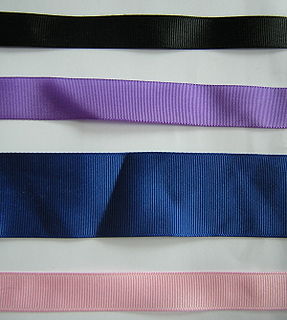
Grosgrain, is a type of fabric or ribbon defined by the fact that its weft is heavier than its warp, creating prominent transverse ribs. It is called a "corded" fabric since the weft resembles a fine cord. Grosgrain is a plain weave corded fabric, with heavier cords than in poplin but lighter than in faille. Grosgrain has a very dull appearance with little luster but is very strong. It is a firm, close-woven, fine-corded fabric. Grosgrain fabric is most commonly available in black, but grosgrain ribbon comes in a large variety of colors and patterns. The ribbon is very similar to Petersham ribbon in its appearance, but it does not have the ability to follow the curves of a surface or edge the way that the latter does.

Ottoman is a crosswise rib pattern with a pronounced ribbed or corded effect, may be knitted or woven. Ottoman is a stiff, heavyweight, crosswise rib structure. In weaving it is a warp faced fabric showing bold weft way rib. The ribbed effect is created by using fine warp yarn with a heavier weft yarn. In knitting, Ottoman rib pattern is knitted with double jersey machines. The ribs lines in an Ottoman may vary in size from thin to coarser by selecting yarny Yarn count and gauge.

A charvet fabric is woven of silk or acetate in warp-faced rib weave, of a reversed reps type with a double ridge effect. The fabric's name derives from its frequent and "clever" use in the 19th century by the Parisian shirtmaker Charvet. It is characterized by a soft handle and shiny appearance. It also drapes well. The bindings create a herringbone effect parallel to the warp, which make this weave suitable for creating faint diagonal stripe effects for ties, for which the fabric is cut on the bias. Patterns on this base are often made with supplementary weft. The fabric has also been used for mufflers, scarves and robes.
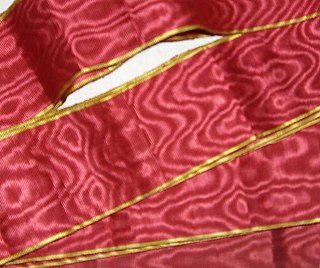
Moire, less often moiré, is a textile with a wavy (watered) appearance produced mainly from silk, but also wool, cotton and rayon. The watered appearance is usually created by the finishing technique called calendering. Moire effects are also achieved by certain weaves, such as varying the tension in the warp and weft of the weave. Silk treated in this way is sometimes called watered silk.

Waffle fabric, also known as honeycomb fabric, has raised threads that form small rectangles. It can be made by either weaving or knitting. Waffle weave is a further exploitation of plain weave and twill weave which produces a three-dimensional effect. The combination of warp and weft floats creates the structure. It is woven partly on tabby areas surrounded by ridges of long floats. The weave consists of warp and weft floats arranged around a plain weave center. The warp and weft threads are interlaced and floating in a way that creates small square ridges and hollows in the fabric in a regular pattern.
Bourette is a shoddy silk fabric with bumps often blended with other yarns. It has a rough surface incorporating multicolored threads and knots of spun silk. The fabric is made with silk bourette and wool or cotton yarn. Bourette is a lightweight single cloth with a rough, knotty, and uneven surface. The name "Bourette" is from its constituting fiber, which is too short of producing schappe. There are two grades of silk yarn, schappe and bourette.
Sussi, or susi, was a term for multicolored striped cloth produced in the Indian subcontinent. Sussi was thin handloom fabric made of cotton, silk, or a blend of the two, with colored warp stripes.
References
- 1 2 Lewandowski, Elizabeth J. (2011). The Complete Costume Dictionary. Lanham, Maryland: Scarecrow Press Inc. pp. 4, 99. ISBN 9780810840041 . Retrieved 6 October 2014.
- 1 2 Tortora, Phyllis G.; Johnson, Ingrid (2014). The Fairchild Books Dictionary of Textiles (8th ed.). New York and London: Fairchild Books (Bloomsbury). p. 213. ISBN 9781609015350 . Retrieved 6 October 2014.
- ↑ "For a spring bride". tudorlinks.com. Tudor Links. Retrieved 6 October 2014.
- ↑ "Coming out day of the silk-warp Eolienne (advert)". The Pittsburgh Press. 15 March 1906. Retrieved 6 October 2014.
| | This article about textiles is a stub. You can help Wikipedia by expanding it. |


